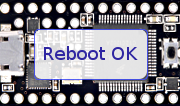Pseudologer
Member
I killed my first teensy 3 mysteriously during experiments with the OctoWS2811 library and circuit, details here.
To prevent killing my second teensy I've:
The prototype ran beautifully for 20 hours plus (one 12 hour session, several smaller ones leading up), everything worked fine. I turned it off after its first event (lights for a party, it's a prototype for a DJ installation), left it over night, and it wouldn't turn on.
I took the teensy out of the socket it was in, reconnected the VUSB trace, plugged it into a computer (win7), uploaded blink. Blink didn't work.
So I have two questions:
I can upload toe code I was running and the circuit schematic if it will help.
Thanks in advance for everyone's time
To prevent killing my second teensy I've:
- Clad my desk in aluminium and grounded it
- Zener (3v3) protected all IO pins in use
- Converted the 3v3 logic signals to 5v through a 74HC245 as reccomended on the OctoWS2811 info page
- Covered the bottom of the circuit board (prototype board currently) with electrical tape so it cant short to the grounded desk
- Current limited all used IO pins with resistors
The prototype ran beautifully for 20 hours plus (one 12 hour session, several smaller ones leading up), everything worked fine. I turned it off after its first event (lights for a party, it's a prototype for a DJ installation), left it over night, and it wouldn't turn on.
I took the teensy out of the socket it was in, reconnected the VUSB trace, plugged it into a computer (win7), uploaded blink. Blink didn't work.
So I have two questions:
- What can I do to prevent a uC dying on me?
- How can I confirm that the Teensy 3 is genuinely dead? (I have an oscilloscope)
I can upload toe code I was running and the circuit schematic if it will help.
Thanks in advance for everyone's time


